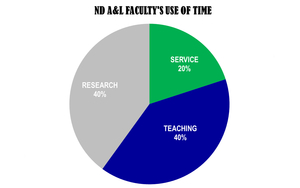 "
"
“You want the best professors who are most passionate about what they’re doing and those are the ones who are doing research. The teachers who are most passionate about their subject are the teachers who want their subject to change the world,” Affleck-Graves says, reflecting on a key component of the finances: faculty and research.
Recruiting and hiring processes vary greatly from college to college. Bill Nichols, associate dean for faculty and research in the Mendoza College of Business, says recruiting is one of Notre Dame’s biggest challenges, attributing it to a variety of factors, including the lack of a PhD program; the geography of the school, as well as its weather; and Notre Dame’s Catholic identity — which can be either a boon or a burden. “We have a huge demand and very little supply of well-credentialed young men and women,” Nichols says. Mendoza remedies this through strong networking connections with various business schools and ND alumni.
Conversely, at the College of Arts and Letters, the process is much more tailored. Although various departments have personalized aspects, in general, the departments make requests for searches they’d like to do, initiating a review by the dean and budget manager. Then comes authorization of said searches; departmental cycles, conferences and reviews; an interview request for three candidates; subsequently, an accordant review and request process and ultimately, a hire. Positions can range from an assistant professorship opening that can garner 500 to 600 applicants to a “targeted search” that could last several years in the recruitment of one person or specific role, Senior Director of Finance and Administration Rob Becht says.
A large part of this recruitment process includes research opportunities. The Office of Research manages this as a whole for the university’s faculty, but each individual college has its own steps in place, particularly for incoming professors.
For Mendoza, as is typical of most business schools, very few grants are in place, meaning that most funding comes from internal sources. Among the major faculty and research costs for the school are substantial summer funding; funding faculty that are attending academic conferences; purchasing, managing and accessing data; designing surveys; and the hiring of clinical faculty in order to alleviate the teaching loads of research faculty.
While the Colleges of Science and Engineering have more prominent opportunities for external funding, that does not diminish the fact that Arts and Letters also competes for a fair amount of external research funding. Many of the humanities require less funding and generally go about it internally, but many of the social sciences regularly pursue external grants.
Overall, while considering full-time faculty members, Mark Schurr, associate dean for social sciences and research, says, “We think about them spending 40 percent of their time on teaching, 40 percent of their time on research and 20 percent of their time on service.” Much of that research seeks to involve students, as well.
A large component of funding these professorships, directorships and academic programs is through the restricted areas of the endowment. These Endowments for Excellence, which began about 20 years ago, “allow the donors to give a gift to a particular area of the university that is [then] unrestricted [within that area]. So they know it’s going to that area, but then it gives that person discretion on how they’re going to use [it],” Nanni says.
Previously, these types of large, eight-figure gifts had only gone to capital projects — now, whether directly or indirectly, they go to support the academy and the students. The endowments, which cover anything from the Rooney Center for American Democracy to the Corgel Family Rector of Dillon Hall, serve as powerful recruiting tools for faculty and students alike and offer direct funding to parts of students’ experiences or, by endowing such positions as a rector or a coach, free up parts of the budget to do so.
Introduction: "The Almighty Dollar: The Financial Landscape of Notre Dame" by Rich Hidy
Part 1: "The Endowment: Not Just a Pot of Gold" by Hunter Kuffel
Part 2: "Tuition" by Katie Harris
Part 3: "Faculty and Research" by Tessa Bangs